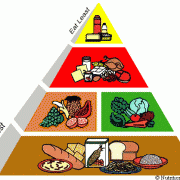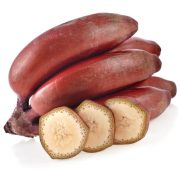There has been a lot of buzz about Omega Essential Fatty Acids in the last number of years, but there still seems to be a lot of confusion about who needs them and what the best sources are.
Here are some key points to remember:
The only fats that are ESSENTIAL to eat in our diet are Omega 3 and Omega 6.
Our bodies can manufacture any other fatty acids our body requires.
We should strive for a 1:1 ratio of Omega 6 fats to Omega 3 fats; we should get at the most a 4:1 ratio. A higher ratio contributes to disease.
North Americans tend to have ratios of 20:1 or as high as 50:1!
Omega 6 oils are readily available in MANY foods.
The purpose of Omega 6 oils is giving rigidity to cell walls.
Undesirable sources are conventionally raised meat and eggs*; canola, soy, and corn oils**
*Animals that are fed a diet primarily consisting of corn as opposed to grass will produce meat, eggs, and milk higher in Omega 6 fats.
**These oils are most often GMO, heavy in pesticides, and oxidized from high temperature refining.
These oils are often found in salad dressings, condiments like mayonnaise, margarine, “vegetable” oil, bread, chips, and crackers.
Omega 6 oils are not ideal for cooking as they are polyunsaturated, making them susceptible to oxidation even at low temperatures – meaning the molecules are less stable and prone to becoming free radicals in your body.
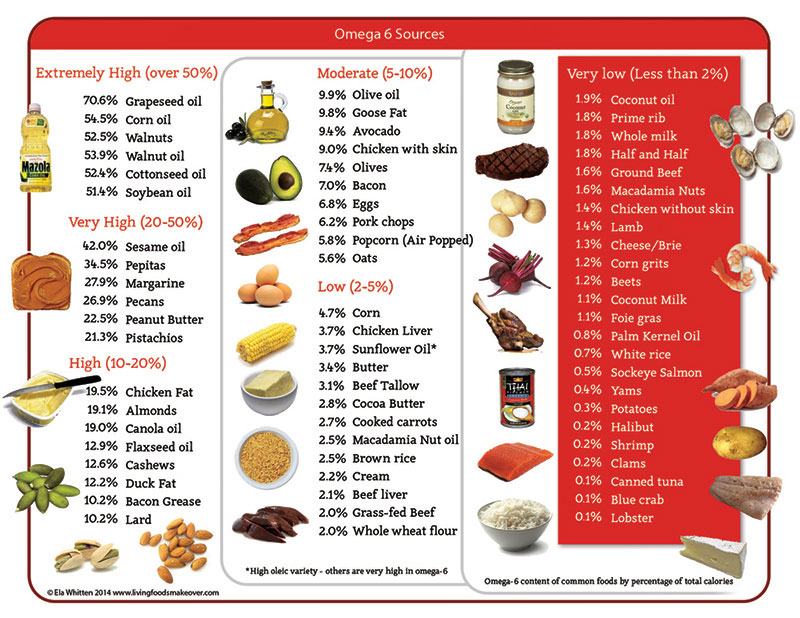
Omega 6 Sources
Desirable sources of Omega 6 are nuts, sunflower, pumpkin, hemp, sesame seeds, and avocado.
We do need some omega 6 in our diets and they should be consumed (in small amounts) in the form of raw nuts, raw seeds and avocados.
These foods are loaded with phytonutrients and fiber.
The antioxidants in nuts and seeds protect the polyunsaturated oils from oxidizing.
It is always better to eat a whole food rather than the concentrated oil.
Almonds are great, but when you remove the oil from the nut, you get an oil that is susceptible to oxidation.
If you love almond or pumpkin seed oil – choose a cold or expeller pressed version, store it in the fridge after opening and do not heat the oil.
Omega 3 oils are scarce in the standard North American diet
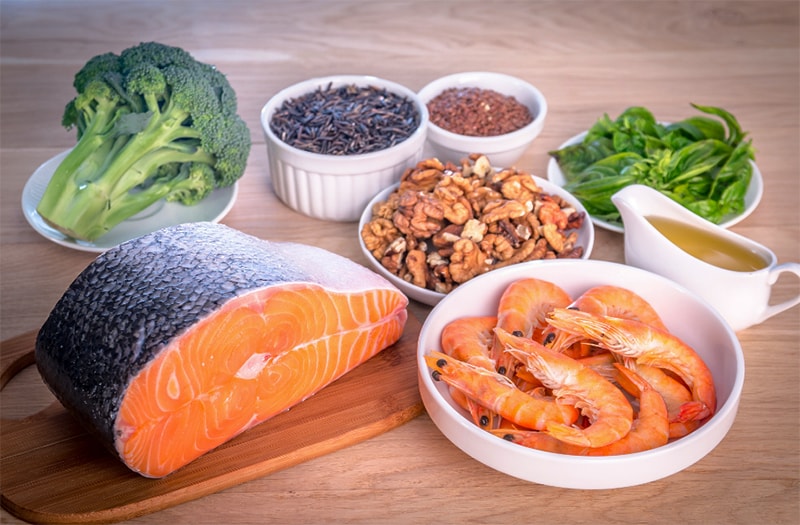
Purpose of Omega 3 is to give cells flexibility. Therefore, it prevents stiff joints and tight muscles and it prevents distortion of receptors on the cell wall so it improves function in virtually every system of the body.
It is also a naturally beneficial blood thinner and an anti-inflammatory.
Undesirable sources are supplements that also contain omega 6 and omega 9 (this does not help you achieve an overall ideal ratio, it completely defeats the purpose of supplementing with omega 3); fish oil or flax oil that has oxidized through poor manufacturing standards or incorrect storage methods; fish oil derived from large fish –higher in the food chain and therefore higher in mercury and PCB contamination.
Desirable sources of Omega 3 in order of preference
#1: Chia seed – though more expensive than flax, are high in calcium and have more antioxidants than flax seed.
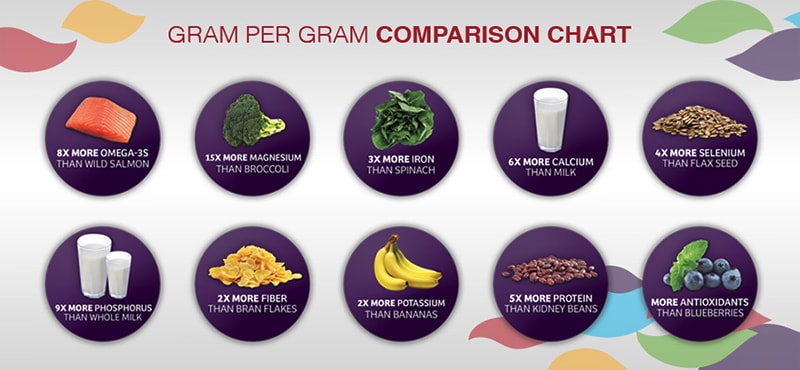
They have a very mild taste and do not have to be ground.
They gel liquids, so you can add them to fresh juice for a natural jello. They are often used in raw desserts and puddings.
Organic Chia seed can be purchased here.
#2: Ground flax seed – ideally grind it fresh, if you have extra, store in the fridge in an air tight container for no more than 3 weeks.
Do not use more than 2 T a day as they can act like a mild estrogen (a phytoestrogen) in your body in higher amounts.
Some people have a deficiency of the enzyme responsible for converting ALA (primarily found in plant sources of Omega 3) into two critical components – EPA and DHA.
There is a blood test to confirm whether you lack this enzyme or not, though I hear it’s rather expensive.
Without conducting the blood test you might suspect this problem if you struggle with eczema, depression or autoimmune disease. If this describes you, consider the following sources.
#3: Microalgae or microalgae Omega 3 supplement – fish are high in omega 3s because they eat algae.
To get around eating fish, we can go directly to the algae.
The benefits are that it is easily grown in controlled environments so it is sustainable and free from environmental contaminants.
It is also safe for those who have fish or shellfish allergies!
Spirulina is an example of microalgae and is considered a superfood due to a high concentration of protein, phytonutrients and omega 3 fatty acids.
Examples of a quality microalgae Omega 3 supplement can be found here.
#3: Certain types of safe fish in moderation. This may include salmon, mackerel, herring, lake trout, sardines and albacore tuna.
#4: High grade fish oil or krill oil – continue reading to see my suggestions.
After explaining the importance of Omega 3s and the sources, the two questions I receive repeatedly are: How much Omega 3 should I take and what brand is reliable?
How much omega 3s should we take?
I base the short answer on Authority Nutrition source.
Here is what they recommend:
- Infants: 0.5 g
- Chidren (1-3): 0.7 g
- Children (4-8): 0.9 g
- Children (9-13): 1.2 g
- Females (14 and up): 1.1 g
- Males (14 and up): 1.6 g
- Pregnancy and Breastfeeding: 1.4 g
Now here is the long answer.
Since we should strive for a 1:1 ratio of Omega 6 to Omega 3 and not exceed a 4:1 ratio, the amount of Omega 3s you take depends on your intake of Omega 6.
For example:
– 1 T ground flax = 1.6 g Omega 3
– Fish oil supplement = 1 g Omega 3
(Total EPA + DHA should = approximately 1 g or 1,000 mg)
If you’re taking ground flax, you’d ideally want to consume 1.6 grams Omega 3 and no more than 6.4 g of Omega 6.
If you are taking both ground flax and fish oil every day–a total of 2.6 g Omega 3–you would ideally want to consume 2.6 g of Omega 3 and no more than 10.4 g of Omega 6.
Here are a few examples of what sources of Omega 6 look like:
2 T Italian Salad dressing = 5.5 grams Omega 6
*11 grams total fat from soybean oil (consists of 50% Omega 6)
23 almonds (1 oz) = 3.4 grams Omega 6
*14 grams total fat
7 tortilla chips = 3.5 grams Omega 6
*7 grams total fat from vegetable oil (50% Omega 6)
1 large home made chocolate chip cookie (made with margarine) = 6.5 grams Omega 6
*13 grams total fat from vegetable oil (50% Omega 6)
Nutrition information came from www.nutritiondata.self.com
So the key is not just to supplement with Omega 3s, but also to cut down on Omega 6.
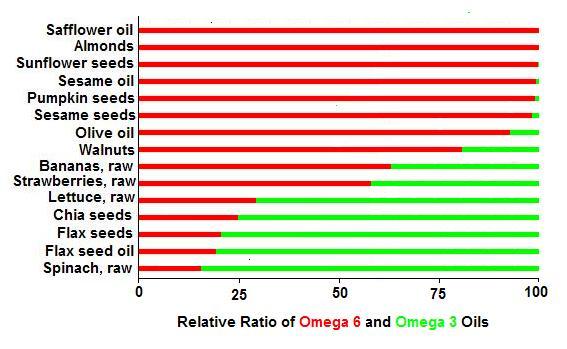
Let’s see some ways to drastically reduce Omega 6 intake:
- Make your own salad dressing with no added oil–use small amounts of ground nuts or seeds to add some fat (small amounts of fat assists in absorbing nutrients from your salad).
- Use nuts to enhance salads or to make creamy sauces rather than snacking on them. 1 oz of nuts can disappear fast when you’re snacking! Snacking on vegetables and hummus is healthy and filling without all the added fats.
- When purchasing nuts – buy raw. Roasted nuts are often coated in extra peanut or vegetable oil, greatly increasing their Omega 6 content. (They are also roasted at high temperatures which can damage the polyunsaturated fats in the nuts.)
- Use very small amounts of coconut oil for oiling pans or baking sheets when cooking. If you don’t have coconut oil, butter is a better option than vegetable oils or margarine. Again–in very small amounts!
What brand of fish oil should I buy?
I recommend that people use chia or flax seed rather than a supplement. And if they choose a supplement, I recommend using a plant sourced Omega 3 supplement, particularly if you are allergic to fish or shellfish.
If you still wish to use fish oil, the quality is very important.
Fish oil needs to be handled correctly with the delicate polyunsaturated fats so they don’t oxidize and it needs to be free of harmful pollutants that fish can be full of!
It is difficult as a consumer to know what brand is best and since supplements are not well regulated, manufacturers can make claims that simply aren’t true.
The easiest way to know if a product is pure and potent, is to see proof that it has been tested and certificated by a 3rd party company.
The downside is that it costs money for a company to be certified so the supplements tend to cost more. I’ve searched for hours for the highest quality Omega 3 products for the best price.
There is an organization called International Fish Oil Standards.
Their website at www.ifosprogram.com says: “Through our certified and accredited reference laboratory partners, we test fish oil products for environmental contaminants including PCBs, mercury, heavy metals, dioxins and furans as well as oxidation levels and omega-3 concentrations in the finished product.”
You can check out the consumer reports on their website.
I investigated most of the brands they certify to find the best cost per gram of combined EPA and DHA (the active version of Omega 3).
Nutrigold brand was significantly cheaper than the rest, but their oil is sourced from fish that are not sustainably harvested and tend to be high in contaminants. The most pure and potent oil at the best cost is Omapure. You can find their products here. The price gets better with a higher volume purchase.
They also have an equally potent/quality liquid version for those who can’t swallow pills which is a bonus.
This is a highly concentrated product, so keep in mind that you might get sufficient Omega 3s from half the dose they recommend. One bottle is labeled as a one month supply, but look at the dosage PER CAPSULE and make the decision about how much you think you need to take and adjust accordingly.
*Since Omega 3s are blood thinning, consult your doctor if you are on blood thinning medication.
There is a greater awareness recently of the benefits of krill oil. Dr. Mercola promotes and sells a brand of krill oil.
Krill is a shellfish that consumes algae.
Since it does not eat other fish—the levels of toxins it accumulates is very low.
Krill oil is also absorbed very well, so you apparently need much lower doses of it which makes it difficult to compare krill oil to fish oil. There is an International Krill Oil Standards program, found at www.ikosprogram.com. A brand that they certify can be found here.

